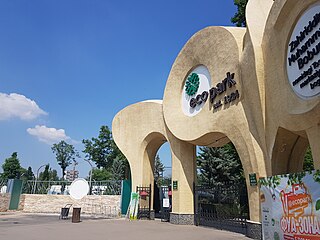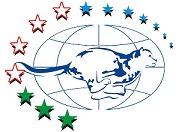As of 2007, Uzbekistan's overland transportation infrastructure declined significantly in the post-Soviet era due to low investment and poor maintenance. Air transport was the only branch that received substantial government investment in the early 2000s, as airport modernization projects were undertaken. In the following years, improvements have been made to the surface transport network including the construction of the Tashkent–Samarkand high-speed rail line.

The Yakovlev Yak-40 is a regional jet designed by Yakovlev. The trijet's maiden flight was in 1966, and it was in production from 1967 to 1981. Introduced in September 1968, the Yak-40 has been exported since 1970.

The Ilyushin Il-76 is a multi-purpose, fixed-wing, four-engine turbofan strategic airlifter designed by the Soviet Union's Ilyushin design bureau as a commercial freighter in 1967, to replace the Antonov An-12. It was developed to deliver heavy machinery to remote, poorly served areas. Military versions of the Il-76 have been widely used in Europe, Asia and Africa, including use as an aerial refueling tanker or command center.

The Yakovlev Yak-42 is a 100/120-seat three-engined mid-range passenger jet developed in the mid 1970s to replace the technically obsolete Tupolev Tu-134. It was the first airliner produced in the Soviet Union to be powered by modern high-bypass turbofan engines.
This is a list of aviation-related events from 1998.
Armenian Airlines was an Armenian airline company and the state-owned flag carrier of Armenia.
JSC Uzbekistan Airways, operating as Uzbekistan Airways, is the flag carrier of Uzbekistan, headquartered in Tashkent. From its hub at Islam Karimov Tashkent International Airport, the airline serves a number of domestic destinations; the company also flies international services to Asia, Europe and North America.

Termez is the capital of Surxondaryo Region in southern Uzbekistan. Administratively, it is a district-level city. Its population is 182,800 (2021). It is notable as the site of Alexander the Great's city Alexandria on the Oxus, as a center of early Buddhism, as a site of Muslim pilgrimage, and as a base of Soviet Union military operations in Afghanistan, accessible via the nearby Hairatan border crossing.
South Airlines was a charter airline based in Odesa, Ukraine.

Tourist activities in Uzbekistan range from outdoor activities, such as rock-climbing, to exploration of its archeological and religious history. The Statistical Internet Survey conducted between May 7 and August 27, 2008, found that the majority of those surveyed (39%) visit Uzbekistan due interest in its architectural and historical sites. The next-largest group (24%) visited Uzbekistan to observe its culture, way of life, and customs.
Prior to the 2001 invasion of Afghanistan, the Islamic Movement of Uzbekistan (IMU) posed the greatest threat to the Karimov administration. In 2002 the IMU was reclassified as terrorist by the United States. Since the invasion, the IMU has been greatly weakened due to US military actions which cut off its supply of resources and killed its leader, Juma Namangani.
China General Aviation Flight 7552 was a China General Aviation flight from Nanjing Dajiaochang Airport to Xiamen Gaoqi International Airport. On July 31, 1992, the Yakovlev Yak-42D overran runway 06 during takeoff and impacted an embankment at 210 kilometres per hour, 420 metres (1,380 ft) from the threshold.
Ikrom Yakubov alleges that he is a former intelligence officer of Uzbekistan, in its National Security Service (SNB), who suggests that he defected to the United Kingdom in 2008. He is notable because, after his defection, he confirmed earlier reports that Uzbekistan routinely tortured captives. In 2008, he also alleged that the crash of Uzbekistan Airways Flight 1154 had been engineered by the Uzbek leadership, killing UN Resident Representative Richard Conroy.

Aeroflot Flight U-505 crashed just after takeoff in Tashkent on 13 April 1987. Flight 505 was an early morning flight from Tashkent to Shahrisabz, both in the Uzbek Soviet Socialist Republic, now the Republic of Uzbekistan. The flight took off just one minute and 28 seconds after an Ilyushin Il-76, thus encountering its wake vortex. The Yakovlev Yak-40 then banked sharply to the right, struck the ground, and caught fire. All 9 people on board died.

Ukrainian-Mediterranean Airlines Flight 4230 was a chartered international passenger flight, a Yakovlev Yak-42D operated by Ukrainian UM Airlines, which crashed in 2003.

Samarkand Airways was an airline based in Uzbekistan that performed passenger and cargo charter flights. Established in 2005 out a joint American-Uzbekistani venture based out of Kentucky, the parent company, Universal Mobility Solutions, provided the aircraft for the fleet. The airline intended to establish a regular scheduled cargo route out of Tashkent to Dushanbe in 2008 using Ilyushin Il-76 and Antonov An-12 aircraft, but such a route was not established. Passenger charters were carried out on Tupolev Tu-154, Yakolev Yak-40 and Avro RJ-85 aircraft, while chartered cargo flights used an Antonov An-26.

The 2001 Faraz Qeshm Airlines Yak-40 crash occurred on 17 May 2001 when a short-haul trijet Yakovlev Yak-40 being operated by Faraz Qeshm Airlines crashed while en route to Gorgan Airport from Tehran-Mehrabad Airport in Iran. The aircraft crashed in mountainous terrain while flying in poor weather conditions about twenty kilometers south of Sari killing all thirty people on board. Passengers aboard the aircraft included Rahman Dadman, Iran's Minister of Roads and Transportation, and six members of parliament.

Aeroflot Flight 120 was an international Soviet passenger flight from Kabul International Airport in Afghanistan to Tashkent International Airport in the Uzbek SSR. On 13 December 1959 the Aeroflot Ilyushin Il-14P operating the flight crashed in the Boysun District killing all 25 passengers and 5 crew on board.










